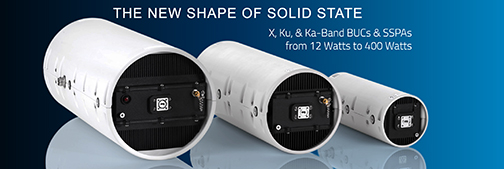
Mission Microwave has released a family of multi-band Ka-band BUCs to support LEO, MEO and GEO missions from a single switchable unit. Covering the range of 27.5 GHz to 30 GHz, these units will be electronically selectable in up to 6 bands covering current and anticipated frequency plans. The new products are enhancements to the existing product lines, which already lead the industry in high power Ka-Band BUC deployments for commercial and Government SATCOM terminals.

Additional product announcements from the company include the introduction of a 150 Watt X-Band BUC in the Javelin package. This rounds out the Javelin product family with a common mechanical and control interface for the 150 Watt X-band, the 100 Watt Ku-band and the 50/100 Watt Ka-Band. Each Javelin BUC weighs under 11 pounds and is ideal for multi-mission terminal designs needing high power tri-band capability.
Mission will exhibit the company's complete product line of high power X-, Ku- and Ka-band amplifiers and BUCs and will have example terminal designs from key industry partners on display in booth #809. Mission products will be on display across the venue incorporated into many industry-leading products from top-tier customers’ mobile and transportable terminals.
Francis Auricchio, President and CEO of Mission Microwave, said customers presented the company with the challenge of enabling a single terminal to be used on a variety of current and emerging satellite network architectures. Satellite industry customers need a well-designed approach to accommodate the changing expectations and resources available to them. The firm's new wideband Ka-band BUCs enable customers to design flexible terminals that can operate on traditional GEO satellites, existing MEO networks and the much-anticipated LEO constellations that are now in the early stages of deployment.

